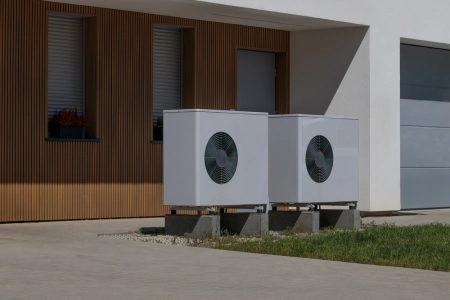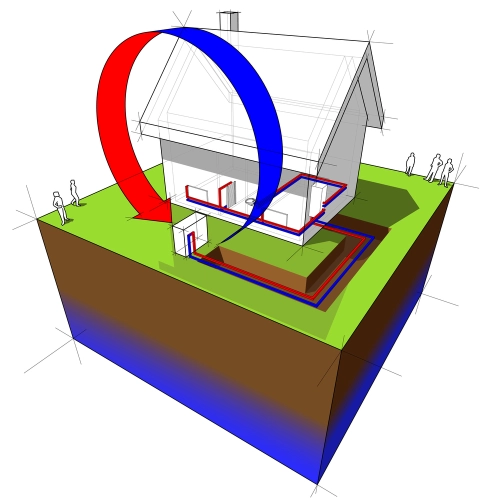
Air source heat pump (ASHP) is an advanced technology that uses the energy contained in the air to provide heating, cooling, and domestic hot water in buildings.
It is an efficient and sustainable form of energy since it takes advantage of a renewable and practically inexhaustible source: outdoor air.
What is an air source heat pump?
Air source heat pump is based on the use of heat pumps, devices that transfer thermal energy from one place to another using a reverse refrigeration cycle. These systems can capture heat from outside air, even in cold conditions, and transfer it inside a building to heat it. Similarly, they can extract heat from inside a building and release it outside to cool the environment.
Thermodynamic principles related
To understand how an air source heat pump works, it is important to know the basic principles of thermodynamics that are involved in its operation:
- First law of thermodynamics (conservation of energy): This law states that energy is neither created nor destroyed, it is only transformed from one form to another. In a heat pump, thermal energy is transferred from outside air to inside the building (or vice versa) through a compression and expansion cycle of a refrigerant.
- Second law of thermodynamics: This law states that heat always flows from a hot body to a cold body naturally. However, with the use of electrical energy (work), a heat pump can reverse this natural flow, extracting heat from a cold source (outdoor air in winter) and transferring it to a warm source (the interior of the building).
Operation of an air source heat pump
 Now that we know the two laws of thermodynamics that intervene in our process, we are going to analyze the operation of these heat machines.
Now that we know the two laws of thermodynamics that intervene in our process, we are going to analyze the operation of these heat machines.
The operation of an air source heat pump is based on a thermodynamic cycle composed of four main processes: evaporation, compression, condensation, and expansion. Let's look at each of them:
- Evaporation (endothermic process): The cycle begins in the evaporator, where the refrigerant absorbs heat from the outside air. Even though the air is cold, the refrigerant has an even lower temperature, which allows heat to flow into the refrigerant, causing it to evaporate and turn into a gas.
- Compression (adiabatic process): The refrigerant in a gaseous state is directed towards the compressor. Here, it is compressed, which increases its temperature and pressure. This process requires mechanical work, usually provided by an electric motor.
- Condensation (exothermic process): The hot, high-pressure gas moves to the condenser, where it transfers its heat to the building's heating system (water or air) by thermal conduction through a heat exchanger. As heat is lost, the refrigerant condenses, turning from a gas to a liquid.
- Expansion (adiabatic process): Finally, the liquid refrigerant passes through an expansion valve, where its pressure decreases drastically. This causes its temperature to also drop, preparing it to return to the evaporator and restart the cycle.
Energy efficiency
The efficiency of a heat pump is measured by the Coefficient of Performance (COP), which is the ratio between the thermal energy provided to the building and the electrical energy consumed by the heat pump. A high COP indicates greater efficiency.
For example, a COP of 4 means that for every unit of electrical energy consumed, the heat pump delivers four units of thermal energy.
Advantages and disadvantages
An air source heat pump has several advantages:
- Energy efficiency: Air-thermal heat pumps are very efficient, with COPs that can reach between 3 and 5, depending on the conditions.
- Versatility: They can provide heating, cooling, and domestic hot water with the same system, adapting to different needs throughout the year.
- Economic savings: Despite the initial investment, the savings in long-term energy costs are significant.
Although air-source heat pumps have many advantages, it also has some drawbacks:
- Weather conditions: The efficiency of heat pumps can decrease in extremely cold climates, although the most advanced technologies are designed to operate efficiently even in adverse conditions.
- Initial cost: Installing an air source heat pump system can be expensive, although aid and subsidies can mitigate this problem.
- Space: Outdoor units require adequate space for installation.
Comparison with solar thermal energy
Air-source heat pumps and solar thermal energy are efficient and sustainable technologies for air conditioning and the production of domestic hot water.
On the one hand, air source heat pumps stand out for their high efficiency, with a Coefficient of Performance (COP) between 3 and 5, which allows them to generate several times more thermal energy than that consumed in electrical power. It is versatile, as it can provide heating, cooling, and domestic hot water, independent of sunlight, and requires less maintenance. However, its efficiency can decrease in cold climates and the initial installation cost is high.
On the other hand, solar thermal energy uses solar radiation, a free and renewable source of energy, it does not emit greenhouse gases, and the operating costs after installation are low. It is ideal for hot water production and heating in sunny regions, although it depends on the availability of sunlight and may need protection from freezing in cold climates. In addition, it requires regular maintenance and adequate space for the solar collectors, with a high initial cost as well.
In comparison, aerothermal is more reliable in various climatic conditions and more suitable for year-round use, while solar thermal is highly efficient in sunny climates but less effective for cooling and cold climates.